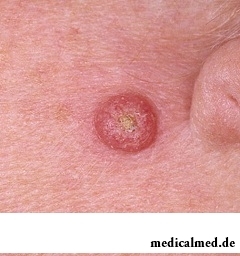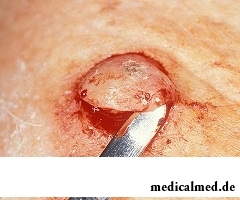





Keratoacanthoma
Keratoacanthoma – a benign tumor which often recurs after a cryolysis and is located on a face, open parts of a body, forearms and extremities, generally at advanced age. Seldom the tumor meets in the sky, cheeks, lips, a nose or under nails.
In 6% of cases the keratoacanthoma in the absence of treatment flows in planocellular cancer. The keratoacanthoma of skin has an appearance of a dome-shaped exophytic node from grayish-red to a blue shade. The central part of a tumor is filled with horn masses, and at the edges it towers over skin level. The keratoacanthoma quickly grows, reaching the big sizes within several days or weeks.
Classification of a keratoacanthoma
Keratoacanthomas divide into the following types:
- Huge (reaching in sizes up to 10-20 mm);
- Solitary (single);
- Keratoacanthomas with peripheral growth;
- Hyponychial which grow from a nail bed to a nail plate in high gear and gradually become similar to the nodes covered with a crust;
- Multiple in combination with immunosuppression and Togge's syndrome;
- Fungoid, having an appearance of flat or convex tumors with a smooth surface which is covered with ortokeratozny masses;
- Multinodulyarnye which it is characterized by existence on a tumor of several craters merging or located separately with formation of large ulcers of irregular shape;
- Tubero-serpiginoznye, having an appearance of the semi-spherical center of irregular shape, with the thinned skin and a small amount of horn masses with the central ulceration.
Keratoacanthoma reasons
Are the reasons of a keratoacanthoma:
- Tobacco smoking;
- Ultra-violet radiation;
- Influence of tar, carcinogens and mineral oils;
- Gene mutations r53;
- Decrease in immunity;
- Radiation;
- Mechanical injuries;
- Genetic predisposition;
- Viral infections (papillomavirus and others).
Development of a keratoacanthoma of skin
In the development the tumor passes through several stages:
- At the first stage the keratoacanthoma is in a stage of active growth which begins with emergence of the small and gradually growing hillock;
- At the second stage the tumor stops in growth and is stabilized;
- At the third stage there comes the phase of sudden regression when the tumor disappears, and on its place the hem is formed.
The third stage usually occurs after 6-9 months after emergence, and at times without surgical intervention never comes. That is or the tumor will disappear, having left behind a hem, or to turn into planocellular cancer.
Diagnosis of a keratoacanthoma of skin
Diagnosing of a tumor happens on the basis of clinical manifestations, by means of an ekstsizionny biopsy and a biopsy of a zone of the roller. On the basis of the conducted researches the stage of a keratoacanthoma and its further treatment is defined.
Treatment of a keratoacanthoma
The keratoacanthoma of skin passes in many cases independently, without demanding any medical intervention, however effects in the form of hems independently do not disappear. This fact and ability to develop into malignant tumors are also the main reasons for surgical treatment of tumors.
Surgical treatment of a keratoacanthoma of skin can be done with the help:
- Laser therapy which deletes new growths on any sites of skin;
- Cryosurgery which is efficient at early stages of a tumor and for which use liquid nitrogen;
- Electrosurgery which is carried out by electric current;
- Cutting off of a tumor surgical scalpel.
Blood of the person "runs" on vessels under huge pressure and at disturbance of their integrity is capable to shoot of distance to 10 meters.

The metabolism at each person proceeds in own way. However dependence between the speed of this process and disposal from superfluous in...
Section: Articles about health
Heart disease and blood vessels lead to disturbance of blood supply of bodies and fabrics that involves failures in their work, deterioration in health of the person, decrease in its working capacity and standard of living. Annually such perishes from pathologies more...
Section: Articles about health
Each person has easy indispositions which he transfers "standing", trying not to ask for medical care. Arguments at the same time are adduced same: "it is a trifle, itself will pass", "I have too many important issues", "there are no wish to spend time for doctors", etc. At good shape of health, normal working capacity and lack of suspiciousness dislike for complaints to such problems is quite natural. It is not the most correct, but very widespread type of behavior. I am glad...
Section: Articles about health
All know that self-treatment is dangerous. However absolutely it is almost impossible to do without it. Rate of modern life not on...
Section: Articles about health
For anybody not a secret that the modern person eats not as his ancestors. For the last 100 years in broad access there were absolutely new products which are result of use of the latest technologies in food production. Significantly changed спо...
Section: Articles about health
Striya (extension) are the defects of skin having an appearance of direct or wavy strips from 1 to 10 cm long and 1-5 mm wide. In most cases at women of a striya are located on a stomach, hips, a breast or buttocks. At athletes they can appear on shoulders and the internal surface of forearms. At initial stages of development of an extension have red or lilac color, but over time their coloring turns pale, and strips become whitish, getting a nacreous shade....
Section: Articles about health
The popular expression "run from a heart attack" became the motto of the people supporting active lifestyle. Moreover, run became peculiar...
Section: Articles about health
The mankind knows that some toxins at intake in the minimum quantities have therapeutic effect from an extreme antiquity. Many substances recognized poisonous are applied in the medical purposes also today, being the main deystvuyushch...
Section: Articles about health
Statistically, pathologies of a thyroid gland in the world more than 500 million people have. Failures in work of this body lead to heavy disbolism, development of heart diseases, vessels, a reproductive and nervous system. In hard cases excess or insufficient production of the main hormones of a thyroid gland (thyroxine and triiodothyronine) leads to essential decline in quality of life and disability....
Section: Articles about health
Sooner or later hair turn gray at all. Many people try to hide these changes, returning natural color of the hair with the help about...
Section: Articles about health
The drugs stopping or oppressing life activity of pathogenic microorganisms are widely applied in clinical practice from 40th years of the last century. Originally antibiotics were called only substances natural (animal, vegetable or микробног...
Section: Articles about health
Olive oil – the product capable to make a powerful contribution to health of the person if it includes it in the diet. The rich vitamin composition of oil does it by a product number one from many diseases including from deadly. Only two tablespoons of oil from olives in day prevent emergence of diseases of vessels and heart, cancer, problems with digestion, presenilation, a depression and many other illnesses which treatment would demand a lot of time and forces. Let's consider on...
Section: Articles about health
For anybody not a secret that our country is one of the most "drinking" in the world. At clear understanding of that the use of strong...
Section: Articles about health
Zone hypostases under eyes - very widespread problem giving to people is a lot of inconvenience. Hypodermic fabric in these parts has very loose structure and almost does not contain collagenic fibers. Besides, the skin covering подглазья constantly is exposed...
Section: Articles about health
Bulimia and anorexia, are heavy deviations of a feeding behavior, become a cause of death of patients much more often than all other nervous breakdowns combined. In 60% of cases two illnesses accompany each other: patients feel horror before danger of set of excess weight and try to refuse as often as possible food, but periodically suffer from attacks of sudden hunger and an uncontrollable overeating. Each patient with anorexia and bulimia needs the help qualified пс...
Section: Articles about health
Many of us, probably, noticed more than once that from intellectual loadings at some point the brain as though "overheats" also "assimilation"...
Section: Articles about health
A lot of things depend on a condition of a backbone in a human body, a backbone - not only a support for a body, it also a receptacle for a spinal cord, that is why malfunctions with a backbone are so dangerous. To treat rachis diseases very difficult and long...
Section: Articles about health
Tuberculosis – a serious infectious disease which development is caused by mycobacteria (Koch's bacilli). The illness is known from an extreme antiquity. Long time fight against it was considered as ineffective. Quite often the disease affected the whole families, and mortality from it was very high. It became the reason of emergence of a set of delusions concerning transmissibility and a possibility of treatment of tuberculosis....
Section: Articles about health
Contrary to popular belief, the multiple sclerosis (MS) is not connected neither with sclerous changes of walls of vessels, nor about age...
Section: Articles about health
Energy saving lamps are one of the most popular products of innovative technologies, and there is no wonder: they much more economic also are more long-lasting than usual filament lamps. At the same time there are fears that energy saving bulbs can become the reasons...
Section: Articles about health
Doctors claim that the people not so familiar with a dorsodynia occur among adult Russians very seldom. At the same time the vast majority of the patients who are periodically testing this indisposition do not hurry to ask for medical care at all. On the one hand, there is an opinion that feelings of this sort at mature age are nearly natural phenomenon which is not doing serious harm to health. With another – practice of self-treatment various obezbol is eurysynusic...
Section: Articles about health
The body of the person almost for 60% consists of water. It is so important for normal functioning of an organism that loss of all is ponut...
Section: Articles about health
There comes the season of issues. Many Russians already dream of outdoor recreation, trips, beautiful seaside beaches. At this time there is no wish to think of problems with health and other unpleasant things, however there are subjects which require attention. Summer...
Section: Articles about health
Physical activity is necessary for normal functioning of a human body. At a lack of the movement joints cease to function, muscles atrophy, cardiovascular activity is broken and the metabolism worsens. The modern city rhythm of life does not provide the person with an adequate exercise stress, additional - sport is necessary. Tedious tasks the huge number of the people having those or ин exists sport not all to liking, but also...
Section: Articles about health
The stroke is one of the most widespread diseases of the person, annually in the world about 6 million cases эт are registered...
Section: Articles about health
Shops of household appliances offer us the huge choice of various devices for the house. Whether there are among this abundance devices which not only facilitate house work, but also help to keep health of the person? Of course, and we will tell about them today....
Section: Articles about health
Reactive pancreatitis - the disease which is characterized by inflammatory process in a pancreas which arises most often because of excess activity of digestive enzymes. It − the emergency state which treatment has to take place in surgical department under control of doctors. The acute inflammation of gland can become the reason of its transition to a chronic form, and also development is purulent - necrotic pancreatitis which the extensive necrosis of fabrics can follow. Zabolev...
Section: Articles about health
